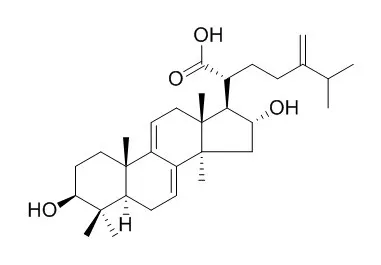| Structure Identification: |
| Anal Sci. 2002 May;18(5):529-31. | | The isolation, identification and determination of dehydrotumulosic acid in Poria cocos.[Pubmed: 12036119] | Poria cocos (Fuling), a popular Chinese medicinal (CM) herb of fungal origin, has been included in many combinations with other CM herbs for its traditionally claimed activities of inducing diuresis, excreting dampness, invigorating the spleen and tranquilizing the mind and its modern pharmacological use of modulating the immune system of the body. Dehydrotumulosic acid, one of the effective constituents of Fuling, was isolated from the chloroform-soluble material of ethanol extract of the fungus.
METHODS AND RESULTS:
After further purification by a high-performance liquid chromatographic method on a C18 column, the purified constituent was identified using modern analytical techniques, such as UV, 13C-NMR and EI-MS. A reversed-phase high-performance liquid chromatographic method has been developed for the determination of Dehydrotumulosic acid in Poria cocos. The determination can be accomplished in less than 50 min using methanol-acetonitrile-2% glacial acetic acid as the mobile phase at a flow rate of 1.0 mL/min, with a UV detector setting at 242 nm and testosterone propionate used as an internal standard.
CONCLUSIONS:
This assay for Dehydrotumulosic acid is simple, rapid and with good reproducibility. | | J Chromatogr B Analyt Technol Biomed Life Sci. 2003 May 25;788(2):387-91. | | High-performance liquid chromatographic method for the determination and pharmacokinetic study of dehydrotumulosic acid in the plasma of rats having taken the traditional chinese medicinal preparation Ling-Gui-Zhu-Gan decoction.[Pubmed: 12705979] |
METHODS AND RESULTS:
A high-performance liquid chromatographic method for the determination of Dehydrotumulosic acid in plasma of rats having been administrated orally with the traditional Chinese medicinal preparation Ling-Gui-Zhu-Gan decoction was developed. Plasma samples taken from rats were acidified with hydrochloric acid and extracted with ethyl acetate. Separation of the main effective constituent Dehydrotumulosic acid was accomplished on a C(18) stationary phase and a mobile phase of methanol-acetonitrile-2% glacial acetic acid (13:12:10, v/v), with a UV detector setting at 242 nm.
CONCLUSIONS:
After validation, the method was used for preliminary investigation of the pharmacokinetic profiles of Dehydrotumulosic acid administrated in Ling-Gui-Zhu-Gan decoction. |
|






 Cell. 2018 Jan 11;172(1-2):249-261.e12. doi: 10.1016/j.cell.2017.12.019.IF=36.216(2019)
Cell. 2018 Jan 11;172(1-2):249-261.e12. doi: 10.1016/j.cell.2017.12.019.IF=36.216(2019) Cell Metab. 2020 Mar 3;31(3):534-548.e5. doi: 10.1016/j.cmet.2020.01.002.IF=22.415(2019)
Cell Metab. 2020 Mar 3;31(3):534-548.e5. doi: 10.1016/j.cmet.2020.01.002.IF=22.415(2019) Mol Cell. 2017 Nov 16;68(4):673-685.e6. doi: 10.1016/j.molcel.2017.10.022.IF=14.548(2019)
Mol Cell. 2017 Nov 16;68(4):673-685.e6. doi: 10.1016/j.molcel.2017.10.022.IF=14.548(2019)